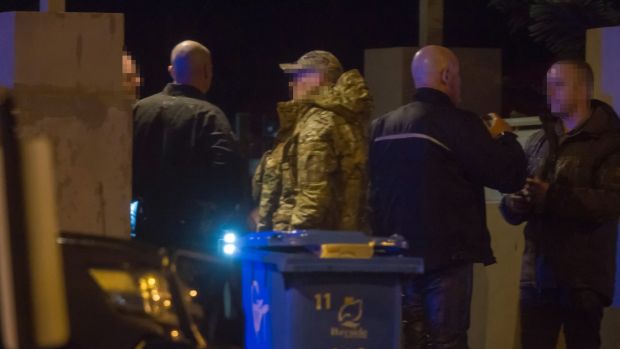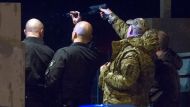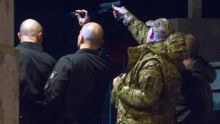- Live coverage Day 2: Police confirm incident was 'an act of terrorism'
- Brighton siege: What we know so far
Police believe the IS-motivated gunman killed in Monday's fatal Brighton siege took a hostage as part of a plan to ambush and kill anti-terror police.
More National News Videos
Brighton siege: video captures gunfire
Witness video shows dramatic scenes after police were called to the building in Bay Street Brighton just after 4pm with reports of an explosion at an apartment building.
The dead gunman, Yacqub Khayre, a man already investigated by police over terror links, rang triple zero and Channel 7, claiming to have a bomb as well as a hostage at the Buckingham Serviced Apartments on Bay Street.
He earlier travelled from his home in Melbourne's north-west, booked into an apartment and then lured a sex worker there, claiming to be a client.
She was tied up before he shot the building's clerk as part of the trap to ambush police.
Sources say he hid outside the building, armed with a sawn-off shotgun and wearing gloves and a balaclava.
He ignored the first police to respond, including the critical incident response team and waited for the special operations group to arrive.
Police say he broke cover and ran towards SOG officers as they congregated near the foyer.

"The first they saw was the muzzled flash," one senior officer said.
Three SOG officers were hit and injured.

Six anti-terror police returned fire, killing Khayre instantly.
The police, who were protected by body armour and shields, suffered pellet injuries to the hands and neck.
One of the police received 18 pellet wounds to his head and neck, while another suffered a finger injury. One was treated at the scene and two were taken to hospital. They are listed as satisfactory.
Police are investigating if the Brighton siege was a copy-cat response to the weekend's London attack that resulted in the death of seven victims and three terrorists.
Khayre was considered a "peripheral player" in a long running anti-terror investigation code-named Neath.
He was charged and acquitted over plans to carry out a suicide attack on Sydney's Holsworthy army barracks.
He was on parole on non-related violent offences.
It is understood Khayre cut off his parole GPS security ankle bracelet on Monday to avoid having his movements monitored.
The IS magazine Rumiyah, as part of its 'Just Terror Tactics' series a month ago, urged supporters to carry out an attack inside a building, using hostages, and for the terrorist to "keep some of his victims alive and restrained, making for a more lengthy and drawn-out hostage scenario".
"One may then notify the authorities, explaining to them that he is a soldier of the Islamic State and informing them of what he has just done," according to the article.
"The intention of this delay is therefore only to prolong the terror, as the ideal scenario is that they storm the location and he is killed as a shahid [martyr] – inshaallah – after having inflicted upon the kuffar a just massacre."
The purpose, the article said, was "not to hold large numbers of the kuffar hostage in order to negotiate one's demands," but to sow terror with "the language of force, the language of killing, stabbing and slitting throats, chopping off heads, flattening them under trucks, and burning them alive".
"The scenario for such an attack is that one assaults a busy, public, and enclosed location and rounds up the kuffar [infidel] who are present. Having gained control over the victims, one should then proceed to slaughter as many of them as he possibly can before the initial police response".
Potential jihadists were instructed to round up hostages inside a building, which "allows one to massacre them while using the building as a natural defense against any responding force attempting to enter and bring the operation to a quick halt".
It also suggested luring people into a place with an advertisement at a job centre, by advertising an apartment for rent, or advertising something for sale on "Craigslist, Gumtree, eBay ... and others".
"Using deception as a tactic of warfare in order to lure one's target or trick them into believing that they are safe before killing them or inconspicuously assasinating them is divinely approved," the article said.
IS has claimed responsibility for the attack.
"The attack in Melbourne, Australia was carried out by a soldier of the Islamic State in response to the call for targeting the subjects of the coalition states," the group's Amaq propaganda agency said.
IS blamed the attack on Australia's membership in the US-led coalition against the militant group.
Court documents reveal that Khayre previously had an affinity with al-Shabbab, the extremist group from his native Somalia.
Police believed he had become radicalised after attending Preston mosque along with other men who were also charged in relation to the Holdsworthy barracks plot.
It was alleged Khayre had also travelled to Somalia as part of preparation for the plot.
Al-Shabbab is yet to declare a partnership with either Islamic State or al Qaeda, but has reportedly been losing fighters to both extremist groups.
Khayre's alleged involvement in a previous terror plot continues a trend which has troubled senior law enforcement figures; how to deradicalise those detected in operations Pendennis and Neath.
- with Michael Bachelard Nino Bucci, Reuters
















